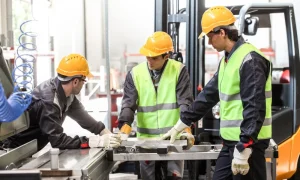In today’s rapidly changing world, sustainable fabrication practices are of utmost importance. Industries are striving to reduce their environmental impact, making it crucial for education to keep pace with evolving trends in sustainable fabrication.
This article explores the concept of eco-fab learning and its potential to contribute to the advancement of eco friendly fabrication practices. By examining the role of education in this field, we can gain insights into strategies and approaches that can be implemented to promote sustainability.
From innovative solutions to the challenges faced, this article provides a comprehensive overview of how education plays a crucial role in driving the development and implementation of eco-friendly fabrication practices.
Key Takeaways
- Sustainable fabrication practices reduce waste and resource consumption, contributing to the conservation of natural resources and the reduction of pollution and greenhouse gas emissions.
- Manufacturers are adopting renewable energy sources and digital fabrication technologies to minimize material waste and energy consumption in the fabrication process.
- The fabrication challenges in sustainable practices include the cost of investment in new technologies, limited availability of eco-friendly materials, skill gaps, resistance to change, and the need for collaboration between businesses, educational institutions, and policymakers.
- Education plays a crucial role in promoting sustainable fabrication by creating awareness, imparting knowledge, keeping fabricators updated on advancements, fostering a culture of sustainability, and enhancing the reputation and competitiveness of the industry.
The Importance of Sustainable Fabrication
Sustainable fabrication practices play a crucial role in addressing environmental concerns and promoting a more eco-friendly approach to manufacturing. With the growing awareness of climate change and the need for sustainable development, industries are now embracing sustainable fabrication as a means to reduce their environmental footprint.
One of the key benefits of sustainable fabrication is the reduction of waste and resource consumption. By implementing efficient manufacturing processes, companies can minimize material waste, energy usage, and water consumption. This not only helps to conserve natural resources but also reduces pollution and greenhouse gas emissions.
Additionally, sustain fabrication practices focus on using renewable and recyclable materials. This ensures that the products being manufactured have a lower impact on the environment throughout their lifecycle. By choosing materials that can be reused or recycled, companies can contribute to the circular economy and reduce the reliance on virgin resources.
Furthermore, eco friendly fabrication practices often prioritize energy efficiency. By using advanced technologies and optimizing processes, manufacturers can significantly reduce energy consumption. This not only reduces operational costs but also helps in mitigating climate change by reducing carbon emissions.
Current Trends in Sustainable Fabrication
With the increasing demand for sustainable manufacturing practices, it is important to stay informed about the current trends in fabrication that are driving the industry towards a more environmentally-friendly future.
One of the major trends in sustainable fabrication is the use of renewable energy sources. Many manufacturers are now adopting solar panels and wind turbines to power their facilities, reducing their reliance on fossil fuels and lowering their carbon footprint.
Additionally, there is a growing emphasis on materials recycling and waste reduction. Companies are actively seeking ways to reuse and repurpose materials in their fabrication processes, reducing the amount of waste sent to landfills.
Another trend is the adoption of green building practices. Sustainable fabrication now involves constructing facilities using environmentally-friendly materials, such as recycled steel and sustainable concrete.
Moreover, there is a shift towards digital fabrication technologies, such as 3D printing, which can minimize material waste and energy consumption. These technologies allow for precise and efficient manufacturing, while also reducing the need for transportation and storage of physical inventory.

Challenges Faced in Sustainable Fabrication Practices
One of the key challenges faced in the realm of sustainable fabrication practices is the need for continuous innovation and technology advancement. As the world becomes more aware of the environmental impact of traditional fabrication methods, there is a growing demand for sustainable alternatives. However, implementing these alternatives can be challenging due to various factors:
- Cost: Fabrication Sustainable practices often require investment in new technologies and equipment, which can be expensive. Many businesses struggle to justify the upfront costs of transitioning to sustainable practices, especially when they are already operating on tight budgets.
- Limited availability of materials: Sustainable fabrication often relies on eco-friendly materials, such as recycled or renewable resources. However, the availability of these materials may be limited, making it difficult for businesses to source them in large quantities.
- Skill gaps: Eco-friendly fabrication practices often require specialized knowledge and skills. However, there is a shortage of professionals who are trained in these practices. This skill gap can hinder the adoption of fabrication sustainable practices in industries that lack the necessary expertise.
- Resistance to change: Change can be challenging, especially for established industries that have been operating using traditional fabrication methods for years. Resistance to change can slow down the adoption of sustainable practices and hinder progress towards a more eco-friendly future.
Addressing these challenges requires collaboration between businesses, educational institutions, and policymakers. By investing in research and development, supporting training programs, and incentivizing sustainable practices, we can overcome these obstacles and create a more sustainable future for fabrication industries.
The Role of Education in Sustainable Fabrication
To address the challenges faced in fabrication sustainable practices, it is crucial to recognize the pivotal role that education plays in driving the adoption of eco-friendly alternatives and fostering a culture of sustainability within the fabrication industry. Education serves as the foundation for creating awareness, imparting knowledge, and developing skills necessary for sustainable fabrication.
Through educational initiatives, individuals gain a deeper understanding of the environmental impact of traditional fabrication methods and are encouraged to seek out more sustainable alternatives.
One of the key ways education contributes to sustainable fabrication is by promoting the use of eco-friendly materials. By teaching students about the environmental benefits of materials such as recycled plastics, bio-based composites, and sustainable woods, educational institutions can inspire future fabricators to prioritize the use of these materials in their projects.
Additionally, education plays a vital role in ensuring that fabricators are aware of the latest advancements and innovations in sustainable fabrication techniques. This includes knowledge about energy-efficient processes, waste reduction strategies, and the use of renewable energy sources.
Furthermore, education fosters a culture of sustainability within the fabrication industry by instilling ethical values and promoting responsible practices. By teaching students about the importance of reducing carbon footprint, conserving resources, and minimizing waste, educational institutions help shape the mindset of future fabricators towards more sustainable and environmentally conscious approaches.
This not only benefits the environment but also enhances the reputation and competitiveness of the fabrication industry as a whole.
Innovative Solutions for Sustainable Fabrication
What are the most innovative solutions available for sustainable fabrication practices?
- Advanced Materials:
One of the key innovations in sustainable fabrication is the development of advanced materials. These materials are designed to be more eco-friendly, using renewable resources and reducing waste. For example, bio-based composites made from natural fibers such as bamboo or hemp are being used as alternatives to traditional materials like plastic or steel.
- Digital Fabrication:
The use of digital technologies such as 3D printing and computer-aided design (CAD) has revolutionized the fabrication process. These technologies allow for precise and efficient production, reducing material waste and energy consumption. Additionally, digital fabrication enables customization and rapid prototyping, leading to more sustainable practices.
- Circular Economy:
The concept of a circular economy aims to minimize waste and maximize the value of resources by reusing, recycling, and repurposing materials. In the context of sustainable fabrication, this means designing products and systems with end-of-life considerations in mind. For example, using modular construction techniques that allow for easy disassembly and reuse of components.
- Energy-efficient Technologies:
Energy consumption is a significant aspect of sustainable fabrication. The use of energy-efficient technologies, such as solar panels, LED lighting, and smart building management systems, can significantly reduce energy consumption in the fabrication process. These technologies not only reduce the environmental impact but also have cost-saving benefits for manufacturers.
These innovative solutions are leading the way towards more sustainable fabrication practices, helping to reduce waste, conserve resources, and mitigate the environmental impact of manufacturing processes.
Implementing Sustainable Fabrication Practices in Your Business
Implementing eco-friendly fabrication practices in your business is crucial for reducing environmental impact, conserving resources, and staying ahead of industry trends. With the growing focus on sustainability and eco-conscious consumers, businesses that embrace sustainable fabrication practices are more likely to attract customers and build a positive brand reputation.
One way to implement fabrication sustainable practices is by optimizing energy usage. By investing in energy-efficient equipment and processes, businesses can reduce their carbon footprint and lower energy costs. Additionally, implementing recycling programs and reducing waste can further contribute to a more sustainable operation.
Another important aspect of fabrication sustainable practices is the use of eco-friendly materials. Businesses can source materials that are renewable, biodegradable, or made from recycled content. This not only reduces the demand for virgin resources but also minimizes waste generation.
Moreover, implementing fabrication sustainable practices can lead to cost savings in the long run. For example, by reducing energy consumption and waste, businesses can lower their operational costs and improve their bottom line.
To ensure the successful implementation of eco-friendly fabrication practices, businesses can seek certifications or partnerships with organizations that promote sustainability. These certifications not only demonstrate a commitment to sustainability but also provide guidance and resources for continuous improvement.
Frequently Asked Questions
What Are the Benefits of Sustainable Fabrication Practices?
The benefits of sustainable fabrication practices include reduced environmental impact, improved resource efficiency, and enhanced product quality. By prioritizing eco-friendly methods, businesses can contribute to a healthier planet while also meeting the demands of socially conscious consumers.
How Can Businesses Overcome the Challenges Faced in Sustainable Fabrication Practices?
Businesses can overcome challenges in fabrication sustainable practices by investing in research and development, adopting innovative technologies, implementing efficient waste management systems, collaborating with sustainable suppliers, and educating employees on best practices.
What Role Does Education Play in Promoting Sustainable Fabrication Practices?
Education plays a crucial role in promoting sustainable fabrication practices by providing knowledge, skills, and awareness about eco-friendly techniques and materials. Through education, individuals can understand the importance of sustainability and contribute to creating a more environmentally conscious and responsible society.
What Are Some Innovative Solutions for Sustainable Fabrication?
Innovative solutions for sustainable fabrication include the use of recycled materials, energy-efficient processes, and the adoption of circular economy principles. These practices aim to minimize environmental impact and promote long-term sustainability in the manufacturing industry.
What Steps Can Businesses Take to Implement Sustainable Fabrication Practices?
Businesses can implement sustainable fabrication practices by conducting a thorough assessment of their current processes, setting clear sustainability goals, investing in eco-friendly technologies, collaborating with suppliers who prioritize sustainability, and educating their employees on sustainable practices.
Conclusion
In conclusion, education plays a crucial role in driving the development and implementation of sustainable fabrication practices. By keeping pace with the trends in sustainable fabrication through eco-fab learning, individuals and businesses can contribute to reducing their environmental impact. Collaboration between educational institutions, industry professionals, and policymakers is essential for the widespread adoption of eco-friendly fabrication practices. By embracing innovative solutions and overcoming challenges, we can work towards a more sustainable future.
You May Also Like:

